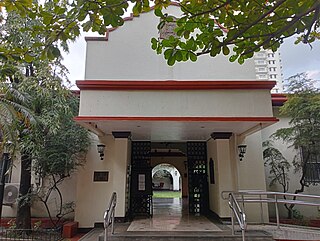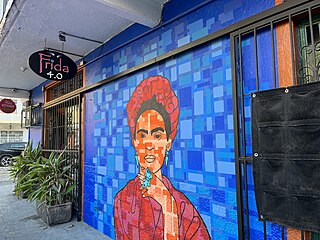
Spanish cuisine consists of the traditions and practices of Spanish cooking. It features considerable regional diversity, with significant differences among the traditions of each of Spain's regional cuisines.

Tapas are appetisers or snacks in Spanish cuisine. They can be combined to make a full meal and are served cold or hot. In some bars and restaurants in Spain and across the globe, tapas have evolved into a sophisticated cuisine. In some Central American countries, such snacks are known as bocas. In parts of Mexico, similar dishes are called botanas.

A margarita is a cocktail consisting of tequila, triple sec, and lime juice. Some margarita recipes include simple syrup as well and are often served with salt on the rim of the glass. Margaritas can be served either shaken with ice, without ice, or blended with ice. Most bars serve margaritas in a stepped-diameter variant of a cocktail glass or champagne coupe called a margarita glass. The margarita is one of the world's most popular cocktails and the most popular tequila-based cocktail.

A tavern is a type of business where people gather to drink alcoholic beverages and be served food such as different types of roast meats and cheese, and where travelers would receive lodging. An inn is a tavern that has a license to put up guests as lodgers. The word derives from the Latin taberna whose original meaning was a shed, workshop, stall, or pub.

Francisco Gómez de Quevedo y Santibáñez Villegas, Knight of the Order of Santiago was a Spanish nobleman, politician and writer of the Baroque era. Along with his lifelong rival, Luis de Góngora, Quevedo was one of the most prominent Spanish poets of the age. His style is characterized by what was called conceptismo. This style existed in stark contrast to Góngora's culteranismo.
Apéritifs and digestifs are drinks, typically alcoholic, that are normally served before (apéritif) or after (digestif) a meal respectively.

Garcilaso de la Vega, KOS was a Spanish soldier and poet. Although not the first or the only one to do so, he was the most influential poet to introduce Italian Renaissance verse forms, poetic techniques, and themes to Spain. He was well known in poetic circles during his lifetime, and his poetry has continued to be popular without interruption until the present. His poetry was published posthumously by Juan Boscán in 1543, and it has been the subject of several annotated editions, the first and most famous of which appeared in 1574.

Gutierre de Cetina (1519–1554) was a Spanish poet and soldier.

Juan Marsé Carbó was a Spanish novelist, journalist, and screenwriter who used Spanish as his literary language. In 2008, he was awarded the Cervantes Prize, "the Spanish-language equivalent" to the Nobel Prize in Literature.
The glossary of wine terms lists the definitions of many general terms used within the wine industry. For terms specific to viticulture, winemaking, grape varieties, and wine tasting, see the topic specific list in the "See also" section below.
Luisa Castro is a Spanish writer and journalist who has published in Galician and Spanish. She has lived in Barcelona, New York City, Madrid, Santiago de Compostela, Naples and Bordeaux. She is currently Director of the Instituto Cervantes in Dublin, Ireland.

A wine bar is a tavern-like business focusing on selling wine, rather than liquor or beer. A typical feature of many wine bars is a wide selection of wines available by the glass. Some wine bars are profiled on wines of a certain type of origin, such as Italian wine or Champagne. While many wine bars are private "stand-alone" establishments, in some cases, wine bars are associated with a specific wine retailer or other outlet of wine, to provide additional marketing for that retailer's wine portfolio. In countries where licensing regulations allow this, some wine bars also sell the wines they serve, and effectively function as a hybrid between a wine shop and a wine bar.
Polo is the name of a flamenco palo or musical form. There is only one known song in this palo, which is extremely similar to another palo called caña, and its guitar accompaniment, like the caña, shares its rhythm and motifs with soleá. Both the caña and polo share the same musical mode. The polo has usually been considered as a derivation of the caña. To complete the singing of the polo, singers usually sing a stanza in the palo of soleá, generally in the style called soleá apolá.

Uruguayan cuisine is a fusion of cuisines from several European countries, especially of Mediterranean foods from Spain, Italy, Portugal and France. Other influences on the cuisine resulted from immigration from countries such as Germany and Scotland. Uruguayan gastronomy is a result of immigration, rather than local Amerindian cuisine, because of late-19th and early 20th century immigration waves of, mostly, Italians. Spanish influences are abundant: desserts like churros, flan, ensaimadas yoo (Catalan sweet bread), and alfajores were all brought from Spain. There are also various kinds of stews known as guisos or estofados, arroces, and fabada. All of the guisos and traditional pucheros (stews) are also of Spanish origin. Uruguayan preparations of fish, such as dried salt cod (bacalao), calamari, and octopus, originate from the Basque and Galician regions, and also Portugal. Due to its strong Italian tradition, all of the famous Italian pasta dishes are present in Uruguay including ravioli, lasagne, tortellini, fettuccine, and the traditional gnocchi. Although the pasta can be served with many sauces, there is one special sauce that was created by Uruguayans. Caruso sauce is a pasta sauce made from double cream, meat, onions, ham and mushrooms. It is very popular with sorrentinos and agnolotti. Additionally, there is Germanic influence in Uruguayan cuisine as well, particularly in sweet dishes. The pastries known as bizcochos are Germanic in origin: croissants, known as medialunas, are the most popular of these, and can be found in two varieties: butter- and lard-based. Also German in origin are the Berlinese known as bolas de fraile, and the rolls called piononos. The Biscochos were re-christened with local names given the difficult German phonology, and usually Uruguayanized by the addition of a dulce de leche filling. Even dishes like chucrut (sauerkraut) have also made it into mainstream Uruguayan dishes.

Chilean cuisine stems mainly from the combination of traditional Spanish cuisine, Chilean Mapuche culture and local ingredients, with later important influences from other European cuisines, particularly from Germany, the United Kingdom and France. The food tradition and recipes in Chile are notable for the variety of flavours and ingredients, with the country's diverse geography and climate hosting a wide range of agricultural produce, fruits and vegetables. The long coastline and the peoples' relationship with the Pacific Ocean add an immense array of seafood to Chilean cuisine, with the country's waters home to unique species of fish, molluscs, crustaceans and algae, thanks to the oxygen-rich water carried in by the Humboldt Current. Chile is also one of the world's largest producers of wine and many Chilean recipes are enhanced and accompanied by local wines. The confection dulce de leche was invented in Chile and is one of the country's most notable contributions to world cuisine.
Mayordomo or Chocolate Mayordomo is a brand of Mexican chocolate para mesa produced by the company Chocolate Mayordomo De Oaxaca, S. De R.L. De C.V., and based in Oaxaca, Oaxaca, Mexico. The company manufactures mole sauce in addition to table chocolate.

Diego Martínez Torrón is a professor of Spanish Literature at the University of Córdoba, Spain, and a writer, author of essays, poetry and novels. He has been a speaker at many of the major universities in Europe and the United States. A specialist in nineteenth and twentieth century Spanish literature he has published numerous books on Spanish Romanticism, with interpretive contributions and unpublished texts. He has edited the most faithful edition of the complete works of authors such as José de Espronceda and the Duque de Rivas. He has also written about Lista and Quintana and the work of Spanish progressive liberals from the early nineteenth century to the end of the period of Romanticism. He has studied the poetic thought of Juan Ramón, Octavio Paz and José Bergamin. He has also dedicated numerous studies to the works of Cervantes. He has studied the narrative of Álvaro Cunqueiro, Juan Benet, Azorín and has published the first annotated edition of El Ruedo Ibérico of Valle-Inclán. His concept of literary methodology stems from a new, non-Marxist approach to the binomial ideology and literature. He has edited Don Quixote, studying the thinking of Cervantes.

Casino Español de Manila is a club established in 1888 by Spaniards living in the Philippines as their exclusive venue for recreational and social activities. It later opened its doors to Filipino members to foster Spanish-Filipino ties in the country. It is located at No. 855 Teodoro M. Kalaw Extension, Ermita, Manila.

Bar Frida Cantina Puerto Vallarta, or simply Bar Frida, is a gay bar in Puerto Vallarta's Zona Romántica, in the Mexican state of Jalisco.


















